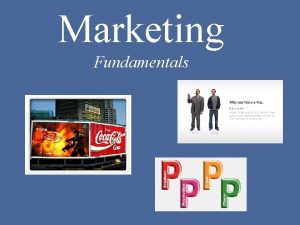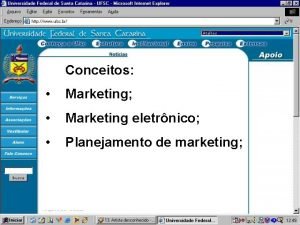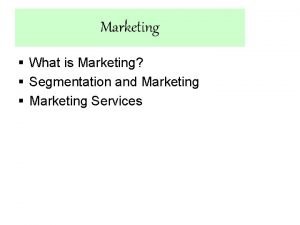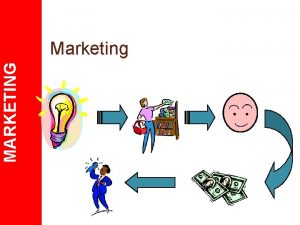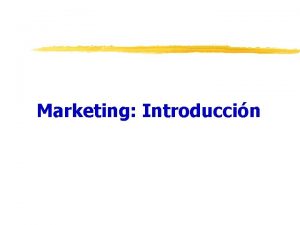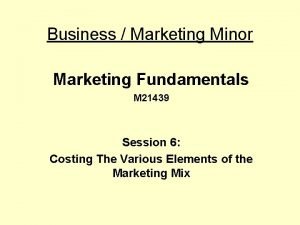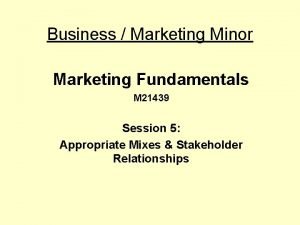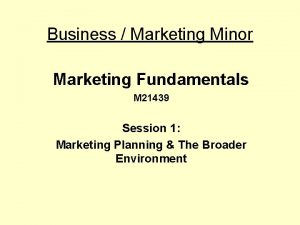CHAPTER 7 Marketing Chapter 7 MARKETING Fundamentals of


































- Slides: 34

------------------ CHAPTER 7: ��� Marketing Chapter 7: MARKETING Fundamentals of International Business Copyright © 2010 Thompson Educational Publishing, Inc.

Key Terms § § § § marketing secondary data primary data centralized strategy decentralized strategy e-distribution sales agent trade show Chapter 7: MARKETING § § royalty target market ethnocentrism demographic information § discretionary income § competitive advantage § economies of scale Fundamentals of International Business Copyright © 2010 Thompson Educational Publishing, Inc.

Chapter Objectives By the time you finish this chapter, you should be able to: § Identify the activities that make up marketing § Describe the modifications made to goods and services to adapt to the cultures of other countries § Identify the challenges an international company may encounter with regard to ethics, values, language, and business practices in the various countries in which it operates § Explain the importance of understanding consumer differences § Identify strategies used by companies to enter foreign markets Chapter 7: MARKETING Fundamentals of International Business Copyright © 2010 Thompson Educational Publishing, Inc.

Marketing Activities Marketing The sum total of all the activities involved in getting goods and services from the original producer to the ultimate consumer. © i. Stockphoto. com These activities include market research, product development, pricing, advertising and promotion, sales, and logistics. Chapter 7: MARKETING Fundamentals of International Business Copyright © 2010 Thompson Educational Publishing, Inc.

Marketing Activities Market research finds or collects data to help solve marketing problems. Secondary data is collected by someone other than the user, for example censuses and surveys. Primary data is observed or collected by a business and relates specifically to its needs or problems. Chapter 7: MARKETING Fundamentals of International Business Copyright © 2010 Thompson Educational Publishing, Inc.

Marketing Activities Product Development Most companies use market research to help develop new products, taking consumer reaction into account. Market research is a major part of product development, as companies don’t want to risk the high costs involved without some assurance that they will be successful. Chapter 7: MARKETING Fundamentals of International Business Copyright © 2010 Thompson Educational Publishing, Inc.

Product Development – Apple Inc. § Do you know who is Jony Ive? § British designer that is the CDO at Apple § He leads the design department and they don’t report to finance, manufacturing etc. § Only few employees have access to their Design studio § When they’re working on a new product, they are separated completely from everyone else Chapter 7: MARKETING Fundamentals of International Business Copyright © 2010 Thompson Educational Publishing, Inc.

Product Development – Apple Inc. § They even implement physical controls to prevent the team from interacting with other employees § Every Monday, Apple holds meetings to examine every single product that the company has in their design phase § Apple only works a few projects at a time to keep their products dominant Chapter 7: MARKETING Fundamentals of International Business Copyright © 2010 Thompson Educational Publishing, Inc.

Marketing Activities Pricing Items that are sold in stores are marked up, as the retailer needs to make money on the items it sells. Chapter 7: MARKETING Fundamentals of International Business Copyright © 2010 Thompson Educational Publishing, Inc. © i. Stockphoto. com The price of a product must take into account the amount of labour, the cost of materials, and overhead (such as electricity).

Marketing Activities Advertising and Promotion Advertising and promotion are needed to convince the customer to buy the product. © i. Stockphoto. com Businesses must identify the best way to reach their target market, taking into consideration the cost of different methods. For example, an Internet ad or brochure is much less expensive than a magazine ad or television commercial. Chapter 7: MARKETING Fundamentals of International Business Copyright © 2010 Thompson Educational Publishing, Inc.

Marketing Activities Sales Businesses must determine the best way to sell their product. Sales methods or venues may include: § Selling products to retailers § Opening their own retail store § Selling online § Selling at an event/show Chapter 7: MARKETING Fundamentals of International Business Copyright © 2010 Thompson Educational Publishing, Inc.

Marketing Activities Logistics consists of the flow of goods and services both into and out of an organization. It consists of transportation, inventory management, warehousing and storage, and packaging. Chapter 7: MARKETING Fundamentals of International Business Copyright © 2010 Thompson Educational Publishing, Inc.

The Four Ps of International Marketing The four Ps of international marketing are: 1. Product 2. Place 3. Price 4. Promotion Chapter 7: MARKETING Fundamentals of International Business Copyright © 2010 Thompson Educational Publishing, Inc.

The Four Ps of International Marketing 1. Product Canadian products sold outside of Canada must usually be modified to adapt to the culture, language, or laws of the foreign market. These modifications usually occur in the following areas: § Packaging: weights, colours, and legal, labelling and language requirements § Ingredients § Style Chapter 7: MARKETING Fundamentals of International Business Copyright © 2010 Thompson Educational Publishing, Inc.

The Four Ps of International Marketing 2. Place A centralized strategy is a marketing strategy in which all of a company’s manufacturing and marketing is performed in one location. A decentralized strategy is a marketing strategy in which a company sets up a manufacturing plant in another nation, or hires a sales force there, or even licenses its brand to a local manufacturer, rather than performing all manufacturing and marketing in one location. Chapter 7: MARKETING Fundamentals of International Business Copyright © 2010 Thompson Educational Publishing, Inc.

The Four Ps of International Marketing 2. Place – cont’d Used under license from Shutterstock, Inc. E-commerce The use of the Internet by businesses to sell products and services to customers in a much larger areas than could be reached through a traditional retail location; using e-distribution, any business anywhere in the world can be an international business. Chapter 7: MARKETING Fundamentals of International Business Copyright © 2010 Thompson Educational Publishing, Inc.

The Four Ps of International Marketing 2. Place – cont’d Sales agent An individual hired and paid a commission by a company to market its product to potential buyers and distributors, often in a foreign country. Trade show A collection of manufacturers and distributors of similar products who rent space, set up display booths, and sell to registered buyers seeking products for their retail businesses. Chapter 7: MARKETING Fundamentals of International Business Copyright © 2010 Thompson Educational Publishing, Inc.

The Four Ps of International Marketing Branch plants Building and staffing a branch plant is the most expensive market entry strategy, but could be the most effective. The three major advantages to owning a branch plant in a foreign country are: § Shipping costs are lower § Import regulations and tariffs are not an issue § Product modifications are easier Chapter 7: MARKETING Fundamentals of International Business Copyright © 2010 Thompson Educational Publishing, Inc.

The Four Ps of International Marketing 2. Place – cont’d A licensing agreement is a contract giving someone the right to use a patent or trademark. Manufacturers pay the owner of the trademark a fee, usually a royalty, which is a percentage of the sale of the licensed product. Chapter 7: MARKETING Fundamentals of International Business Copyright © 2010 Thompson Educational Publishing, Inc.

The Four Ps of International Marketing 2. Place – cont’d Three types of licensing agreements: § Manufacturing agreements—the rights to manufacture a product § Distribution agreements—the rights to sell a product § Franchising agreements—grants the ownership of a manufacturing or distribution company to a local franchisee Chapter 7: MARKETING Fundamentals of International Business Copyright © 2010 Thompson Educational Publishing, Inc.

The Four Ps of International Marketing Number of Subway Restaurant franchise locations worldwide Chapter 7: MARKETING Fundamentals of International Business Copyright © 2010 Thompson Educational Publishing, Inc.

The Four Ps of International Marketing 2. Place – cont’d Acquisitions The most effective way for a company to deal with competition in a foreign or domestic market is to buy the company it competes with, then close it or use its marketing connections to expand its market. Chapter 7: MARKETING Fundamentals of International Business Copyright © 2010 Thompson Educational Publishing, Inc.

The Four Ps of International Marketing 3. Price § Companies that use a centralized market entry strategy find that they must increase the price of their product when selling in foreign markets § Sometimes the price of their product increases to the point that it is no longer competitive Chapter 7: MARKETING Fundamentals of International Business Copyright © 2010 Thompson Educational Publishing, Inc.

The Four Ps of International Marketing 3. Price – cont’d These increases in price arise because of added expenses in the following areas: § Labour costs: Labour in foreign countries is often much cheaper than in Canada. § Shipping costs: The cost to ship goods long distances must be factored into their price. § Duties and tariffs: Some countries charge a tax on imports to protect local industries. § Legal costs: Modifications to conform to standards in a foreign market can be expensive. Chapter 7: MARKETING Fundamentals of International Business Copyright © 2010 Thompson Educational Publishing, Inc.

The Four Ps of International Marketing 4. Promotion There are three ways to promote and advertise products when selling in a foreign market: § Use existing ads: Saves money, but markets must be similar. § Translate ads: Replicating an ad campaign in another language is difficult. § Create new ads: Expensive, but the Internet has made customizing promotions much easier. Chapter 7: MARKETING Fundamentals of International Business Copyright © 2010 Thompson Educational Publishing, Inc.

The Two Cs of International Marketing After a company has decided on its product, price, place, and promotion, it must ensure that there is enough demand for its product. © i. Stockphoto. com Demand involves two factors (often referred to as the two Cs of international marketing): Chapter 7: MARKETING 1. Consumers 2. Competition Fundamentals of International Business Copyright © 2010 Thompson Educational Publishing, Inc.

The Two Cs of International Marketing 1. Consumers A business must determine its target market. This is the segment of the consumer market to which a particular good is targeted. Target markets are typically defined by demographic information, which is statistical data about various aspects (age, gender, etc. ) of the population. Chapter 7: MARKETING Fundamentals of International Business Copyright © 2010 Thompson Educational Publishing, Inc.

The Two Cs of International Marketing Canadian businesses wanting to sell abroad must avoid ethnocentrism, the belief that your own culture, values, beliefs, and customs represent the right way of doing things, and that other value systems are not important. Chapter 7: MARKETING Fundamentals of International Business Copyright © 2010 Thompson Educational Publishing, Inc.

The Two Cs of International Marketing Used under license from Shutterstock, Inc. Ways to avoid ethnocentric thinking: Chapter 7: MARKETING § Visit the country you want to include in your marketing plan. § Read country profiles, especially information provided by the Department of Foreign Affairs and International Trade. § Offer your product on the Internet in the language of the target nation to determine if there is demand for it. Fundamentals of International Business Copyright © 2010 Thompson Educational Publishing, Inc.

The Two Cs of International Marketing Used under license from Shutterstock, Inc. A business entering a foreign market must determine whether consumers will be able to afford to buy its product. Discretionary income is the money remaining from an individual’s salary or wages after all essential living expenses, including rent and groceries, have been paid. Chapter 7: MARKETING Fundamentals of International Business Copyright © 2010 Thompson Educational Publishing, Inc.

The Two Cs of International Marketing 2. Competition Similar products that already exist in a foreign market are a major marketing problem. There are two types of competition: § Direct: Businesses that provide products or services that are almost identical to those offered by the company are direct competitors. § Indirect: Consumers in every country have a certain amount of discretionary income, and regular spending habits. Any product that vies for consumers’ spending money is competition. Chapter 7: MARKETING Fundamentals of International Business Copyright © 2010 Thompson Educational Publishing, Inc.

The Two Cs of International Marketing Competitive advantage In marketing, the ability of one company to produce a product more cheaply than another company. Chapter 7: MARKETING Fundamentals of International Business Copyright © 2010 Thompson Educational Publishing, Inc.

The Two Cs of International Marketing Typical competitive advantages are: § Lower production costs: According to theory of economies of scale, the more products you can make in one factory, using the same labour and sharing overhead costs, the cheaper each individual unit is to make. § Lower distribution costs: Companies with factories in their target market have lower costs. § Product differentiation: Difference in flavour, quality, packaging, scent, etc. § Brand equity: The number of consumers that can identify the brand. Chapter 7: MARKETING Fundamentals of International Business Copyright © 2010 Thompson Educational Publishing, Inc.

Foreign Marketing and Canadian Shopping Habits § Canadian businesses must stock goods from around the world to compete with online retailers. § Retailers must guarantee a unique selection of products by visiting international trade shows or accessing online distributors. § Increase in foreign ownership of Canadian manufacturers means it is more difficult to buy Canadian-made goods. § Canadian businesses must remind shoppers that they sell and produce Canadian goods. Chapter 7: MARKETING Fundamentals of International Business Copyright © 2010 Thompson Educational Publishing, Inc.
 Fundamentals of nursing chapter 1 notes
Fundamentals of nursing chapter 1 notes Fundamentals of electric circuits chapter 4 solutions
Fundamentals of electric circuits chapter 4 solutions Fundamentals of corporate finance chapter 6 solutions
Fundamentals of corporate finance chapter 6 solutions Digital fundamentals chapter 4
Digital fundamentals chapter 4 Conceptual physics magnetism
Conceptual physics magnetism Tire wheel and wheel bearing fundamentals
Tire wheel and wheel bearing fundamentals Understanding your health and wellness
Understanding your health and wellness 9
9 Fundamentals of electric circuits chapter 7 solutions
Fundamentals of electric circuits chapter 7 solutions Fundamentals of building construction chapter summaries
Fundamentals of building construction chapter summaries Computer fundamentals chapter 1
Computer fundamentals chapter 1 Fundamentals of corporate finance, chapter 1
Fundamentals of corporate finance, chapter 1 Fundamentals of thermal-fluidsciences chapter 1 problem 13p
Fundamentals of thermal-fluidsciences chapter 1 problem 13p Principles of information systems
Principles of information systems Fundamental of information system
Fundamental of information system Chapter 17 fundamentals of nursing
Chapter 17 fundamentals of nursing Chapter 6 fingerprints
Chapter 6 fingerprints What is lodging operations
What is lodging operations Chapter 2 lab java fundamentals
Chapter 2 lab java fundamentals Back channeling nursing
Back channeling nursing Examples of the respiratory system
Examples of the respiratory system Chapter 39 electrical fundamentals
Chapter 39 electrical fundamentals Fundamentals of thermal-fluidsciences chapter 1 problem 19p
Fundamentals of thermal-fluidsciences chapter 1 problem 19p Fundamentals of thermal-fluidsciences chapter 2 problem 18p
Fundamentals of thermal-fluidsciences chapter 2 problem 18p Chapter 15 critical thinking in nursing practice
Chapter 15 critical thinking in nursing practice Glencoe health chapter 1 understanding health and wellness
Glencoe health chapter 1 understanding health and wellness Fundamentals of thermal-fluidsciences chapter 1 problem 19p
Fundamentals of thermal-fluidsciences chapter 1 problem 19p Fundamentals of thermal-fluidsciences chapter 1 problem 13p
Fundamentals of thermal-fluidsciences chapter 1 problem 13p Stress and adaptation fundamentals of nursing
Stress and adaptation fundamentals of nursing Fundamentals of thermal-fluidsciences chapter 1 problem 24p
Fundamentals of thermal-fluidsciences chapter 1 problem 24p Fundamentals of corporate finance, chapter 1
Fundamentals of corporate finance, chapter 1 Fundamentals of thermal-fluidsciences chapter 2 problem 30p
Fundamentals of thermal-fluidsciences chapter 2 problem 30p Fundamentals of thermal-fluidsciences chapter 2 problem 25p
Fundamentals of thermal-fluidsciences chapter 2 problem 25p Chapter 23 computer system fundamentals
Chapter 23 computer system fundamentals Certification in hotel industry analytics
Certification in hotel industry analytics



































